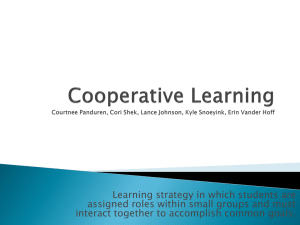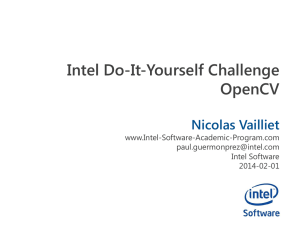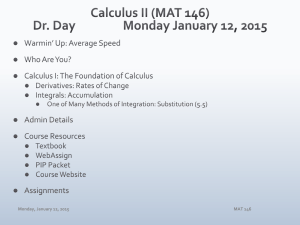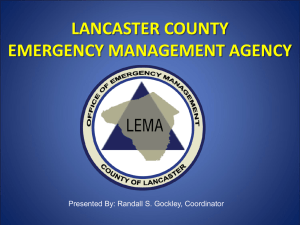OpenCV
advertisement
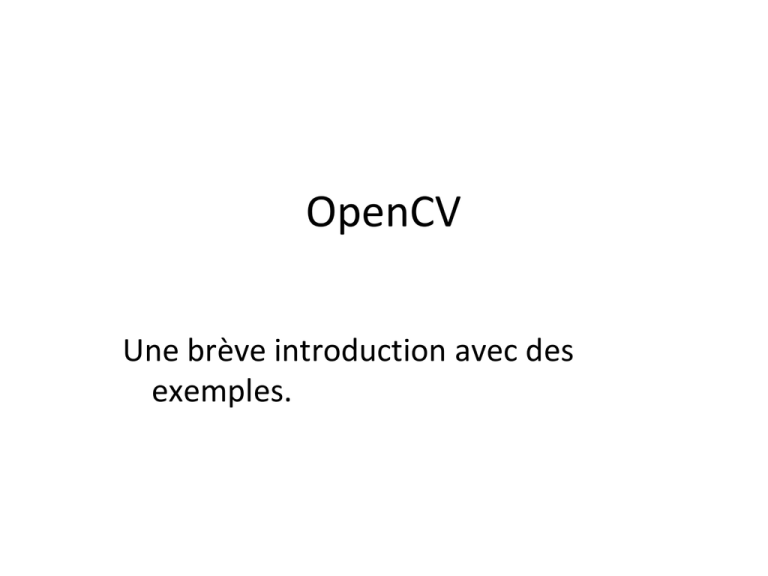
OpenCV
Une brève introduction avec des
exemples.
Sommaire
1. Introduction
2. Structure de base de OpenCV : The Core
Functionality
<http://opencv.itseez.com/modules/core/doc/core.html> ,
http://opencv.itseez.com/index.html,
(CV::Mat) –classe foindamentale pour représentation des images et des images
vidéo
*differents types de codage (RGB, Grey, RGB= alpha -- structure de
données)
3. HighGUI : gestion des image, affichage, lecture ,-ecriture
High-level GUI and Media I/O
<http://opencv.itseez.com/modules/highgui/doc/highgui.html>
4. Traitements d'images et videos modes et algorithmes pour les applications de
mobilité
Introduction
OpenCV (pour Open Computer Vision) est une
bibliothèque graphique libre, initialement
développée par Intel, spécialisée dans le
traitement d'images en temps réel.
Elle peut être utilisée dans une application
Android en grâce au jni (Java Native Interface).
26/10/11
Introduction
Pourquoi?
Téléphon eMobile : outil de communication
multimédia :
Prendre des photos bien focalisées,
Envoyer les vidéos : « citizen reporteur » - BBC,
BFMTV, sécurité : MotionCam,
Filtrer l’information personnelle,
Consulter les BD images
Filtrage de l’information personnelle
26/10/11
Structure de base de OpenCV
OpenCV 2.x is a C++ library as opposed to
OpenCV 1.x
Significant changes in module structure since
version 2.2
Modules: core, imgproc, video, calib3d,
features2d, objdetect, highgui, gpu...
OpenCV core functionality
All the OpenCV classes and functions are
placed into the cv namespace
core - compact module defining basic data
structures and basic functions used by all
other modules
Basic image class cv::Mat
26/10/11
cv::Mat memory management
OpenCV handles all the memory
automatically
Memory is freed automatically when needed
When a Mat instance is copied, no actual
data is really copied
To make a real copy, use Mat::clone
26/10/11
The Mat class I
• cv::Mat covers the old CvMat and IplImage
– Data representation
• Data is row ordered
• Colour pixels are interleaved (e. g. RGBRGBRGB...)
• Let's see some important members of the class:
– Create and initialize
// Mat(int _rows, int _cols, int _type);
// Mat(Size _size, int _type); type = CV_8UC3, CV_32FC1, ...
// Mat(Size _size, int _type, const Scalar& _s); fill with values in _s
Mat M(7,7,CV_32FC2,Scalar(1,3));//7x7, float, 2 channels, fill with (1,3)
M.create(Size(15,15), CV_8U);//reallocate (if needed)
//Matlab-like initializers
Mat ident = Mat::eye(3,3, CV_32F);//also Mat::ones(..) and Mat::zeros(..)
int* data = {1,2,3,9,0,-3};
Mat C (2,3,CV_32S, data); //no data copied.
C = C.clone(); //clone the matrix -> now the data is created.
26/10/11
The Mat class II
Important things to know:
Shallow copy: Mat A = B; does not copy data.
Deep copy: clone() and/or B.copyTo(A); (for ROIs,
etc).
Most OpenCV functions can resize matrices if needed
Lots of convenient functionality (Matrix expressions):
26/10/11
s is a cv::Scalar, α scalar (double)
Addition, scaling, ...: A±B, A±s, s±A, αA
Per-element multiplication, division...: A.mul(B), A/B,
α/A
Matrix multiplication, dot, cross product: A*B, A.dot(B),
A.cross(B)
Transposition, inversion: A.t(), A.inv([method])
And a few more.
Mat class: element access I
Rows, columns, ROIs,...
Mat A = B.row(int row); //same for B.col()
A = B.rowRange(Range rg);//same for B.colRange()
A = B(Rect r);//use a rectangle to set ROI
Ranges, ROIs, etc... only create new headers.
Where is a ROI in the bigger matrix?
Mat A = B(Rect r);
Size s; Point offset;
A.locateROI(s, offset); //'s' and 'offset' will
define the rectangle 'rect'
Element access: 3 options
Using at<>()
double val = M.at<double>(i, j);//You have to
know the type
26/10/11
Mat class: element access II
Old C style.
// compute sum of positive matrix elements
double sum=0;
for(int i = 0; i < M.rows; i++)
{
const double* Mi = M.ptr<double>(i); //we know it's
double data
for(int j = 0; j < M.cols; j++)
sum += std::max(Mi[j], 0.);
}
STL-like iterators
// compute sum of positive matrix elements, iteratorbased variant
double sum=0;
MatConstIterator_<double> it = M.begin<double>(), it_end
= M.end<double>();
for(; it != it_end; ++it)
sum += std::max(*it, 0.);
This iterators can be used with STL functions, like std::sort()
26/10/11
The Mat_ class I
A thin wrap around the Mat class. Mat ↔ Mat_ can
be converted freely
With care: no data conversion is done
Type specification is different
Useful if you do lots of element access.
Same internal code, but shorted to write
Mat_<double> M(20,20); //a double matrix
20x20
double k = M(2,18); //no data specification
needed
For multichannel (colour images), use cv::Vec
Mat_<Vec3f> M3f(20,20); //a 20x20 3 channel
float matrix
26/10/11
Image examples
Mat_<uchar> (8 bpp)
26/10/11
Mat_<Vec3u> (24 bpp)
Manipulation with images using Mat
class
Reading and writing images is easy
Mat imread(const string& filename, int flags=1);
//flags =0 -> always grayscale
//flags >0 -> always color
//flags <0 -> read image as-is
bool imwrite(const string& filename, const Mat& img,
const vector<int>& params=vector<int>());
//params set compressions values. defaults are fine.
example:
Mat img = imread("filename.jpg", 1);
imwrite("file.png", myImage);
26/10/11
Examples: thresholding
#include <cv.h>
#include <highgui.h>
using namespace std;
using namespace cv;
int main( int argc, char** argv )
{
Mat src, gray, grayThresh;
src = imread(argc >= 2 ? argv[1] : "fruits.jpg", 1);
gray.create(src.size(), CV_8U);//not needed, actually
namedWindow("src", CV_WINDOW_AUTOSIZE);
namedWindow("gray", CV_WINDOW_AUTOSIZE);
namedWindow("grayThreshold", CV_WINDOW_AUTOSIZE);
cvtColor(src, gray, CV_BGR2GRAY); //color images are BGR!
threshold(gray, grayThresh, 100, 250, CV_THRESH_BINARY);
imshow("src", src);
imshow("gray", gray);
imshow("grayThreshold", grayThresh);
waitKey(0); //waits for a key: it also handles the GUI events.
}
return 0; //no need to free the matrices, they are deleted
automatically
26/10/11
Examples: Canny edge detector
#include <cv.h>
#include <highgui.h>
using namespace std;
using namespace cv;
int main( int argc, char** argv )
{
Mat src, dst;
src = imread(argc >= 2 ? argv[1] :
"fruits.jpg", 0);
// dst = Mat(src.size(), src.type());
Canny(src, dst, 100, 150, 3);
namedWindow("src"); imshow("src", src);
namedWindow("canny"); imshow("canny", dst);
WaitKey(0);
return 0;
}
26/10/11
HighGUI: Creating Interfaces I
Start off by creating a program that will constantly input
images from a camera
#include <cv.h>
#include <highgui.h>
int main()
{
CvCapture* capture = 0;
capture = cvCaptureFromCAM(0);
if(!capture)
{
printf("Could not initialize capturing...\n");
return -1;
}
cvNamedWindow("video");
This code creates a capture structure pointing to camera
#0 and creates a window named “video”
26/10/11
HighGUI: Creating Interfaces II
Create two variables holding the values of the trackbars we’ll create
int bright=128, contrast=26;
And now we actually create the trackbars:
cvCreateTrackbar("brightness", //name of the trackbar
"video", //name of the window
&bright, //pointer to a variable that will hold the value of
the trackbar)
255,
//maximum value of the trackbar (minimum is always 0)
NULL);
//A callback function (which is called whenever the
position of the trackbar is changed)
cvCreateTrackbar("contrast", "video", &contrast, 50, NULL);
•
Start the infinite loop requesting for frames:
while(true)
{
IplImage* frame = 0;
frame = cvQueryFrame(capture);
if (!frame)
break;
26/10/11
HighGUI: Creating Interfaces III
bright is in range [0,255], thus subtract 128 to have a convenient range 127...128 to reduce to increase brightness.
Modify image contrast and brightness by adding to every pixel bright value and
scaling by contrast
cvAddS(frame, cvScalar(bright-128,bright-128,bright128), frame);
Display the image in the window “video” until the Esc key (ASCII = 27) is pressed
cvShowImage("video", frame);
int c = cvWaitKey(20);
if ((char)c==27)
break;
}
cvReleaseCapture(&capture);
return 0;
}
26/10/11
HighGUI: trackbar example
26/10/11
OpenCV: image filtering
• In this tutorial you will learn how to apply
diverse linear filters to smooth images using
OpenCV functions such as:
• Blur
• Gaussian blur
• Median blur
• Bilateral filter
26/10/11
Theory
• Smoothing (blurring) is a simple and frequently used
operation
• There are many reasons for smoothing, e.g. noise suppression
• To perform a smoothing operation we will apply a filter to our
image. The most common type of filters are linear, in which
an output pixel’s value (i.e. 𝑔(𝑖, 𝑗)) is determined as a
weighted sum of input pixel values (i.e. 𝑓(𝑖 + 𝑘, 𝑗 + 𝑙)) :
𝑔 𝑖, 𝑗 =
𝑓 𝑖 + 𝑘, 𝑗 + 𝑙 ℎ(𝑘, 𝑙)
𝑘,𝑙
• ℎ(𝑘, 𝑙) is called the kernel, which is nothing more than the
coefficients of the filter.
• It helps to visualize a filter as a window of coefficients sliding
across the image.
26/10/11
Normalized Box Filter
• This filter is the simplest of all! Each output
pixel is the mean of its kernel neighbors (all of
them contribute with equal weights)
• The kernel is below:
1 … 1
1
𝐾=
… … …
𝐾𝑤𝑖𝑑𝑡ℎ ∗ 𝐾ℎ𝑒𝑖𝑔ℎ𝑡
1 … 1
26/10/11
Gaussian Filter I
• Probably the most useful filter (although not
the fastest). Gaussian filtering is done by
convolving each point in the input array with
a Gaussian kernel.
• 1D Gaussian kernel
26/10/11
Gaussian Filter II
• Pixel located in the middle has the biggest
weight.
• The weight of its neighbors decreases as the
spatial distance between them and the center
pixel increases.
• 2D Gaussian kernel
• where 𝜇 is the mean (the peak) and 𝜎 represents
the variance (per each of the variables 𝑥 and 𝑦)
26/10/11
Median filter
• The median filter run through each element of
the signal (in this case the image) and replace
each pixel with the median of its neighboring
pixels (located in a square neighborhood
around the evaluated pixel).
• The median of a finite list of numbers can be
found by arranging all the observations from
lowest value to highest value and picking the
middle one.
26/10/11
Bilateral Filter
• Considered filters main goal were to smooth an input
image. However, sometimes the filters do not only dissolve
the noise, but also smooth away the edges. To avoid this (at
certain extent at least), we can use a bilateral filter.
• In an analogous way as the Gaussian filter, the bilateral
filter also considers the neighboring pixels with weights
assigned to each of them.
• These weights have two components
– The first component is the same weighting used by the Gaussian
filter
– The second component takes into account the difference in
intensity between the neighboring pixels and the evaluated one.
26/10/11
Usage examples
• Box filter
blur(src, dst, Size( filt_size_x, filt_size_y), Point(-1,1));
–
–
–
–
src: Source image
dst: Destination image
Size( w,h ): Defines the size of the kernel to be used ( of width w pixels and height h pixels)
Point(-1, -1): Indicates where the anchor point (the pixel evaluated) is located with respect to
the neighborhood. If there is a negative value, then the center of the kernel is considered the
anchor point.
• Gaussian blur
GaussianBlur( src, dst, Size(filt_size_x, filt_size_y ),
0, 0 );
– Size(w, h): The size of the kernel to be used (the neighbors to be considered). and have to be
odd and positive numbers otherwise the size will be calculated using the and arguments.
– sigma_x: The standard deviation in x. Writing 0 implies that is calculated using kernel size.
– sigma_y: The standard deviation in y. Writing 0 implies that is calculated using kernel size.
26/10/11
TD
• Détection de visages
• Masquage
26/10/11
Usage examples II
• Median blur
medianBlur(src, dst, filt_size
– src: Source image
– dst: Destination image, must be the same type as src
– i: Size of the kernel (only one because we use a square window).
Must be odd.
• Bilateral filter
bilateralFilter ( src, dst, filt_size ,
filt_size *2, filt_size /2 )
– d: The diameter of each pixel neighborhood.
– sigma_col: Standard deviation in the color space (pixel values).
– sigma: Standard deviation in the coordinate space (in pixels)
26/10/11
Median blur example
26/10/11
Face detection
Slides partly borrowed from
http://www.cs.unc.edu/~lazebnik/spring09/lec23_face_detection.ppt
26/10/11
Face detection II
• Basic idea: slide a window across image and
evaluate a face model at every location
• Challenges:
• Sliding window detector must evaluate tens of
thousands of location/scale combinations
• Faces are rare: 0–10 per image
• For computational efficiency, we should try to spend as little
time as possible on the non-face windows
• A megapixel image has ~106 pixels and a comparable
number of candidate face locations
• To avoid having a false positive in every image, our false
positive rate has to be less than 10-6
26/10/11
Object classification
• Takes as input 𝑛-dimensional vector of
parameters 𝑣
• Training step: given a number of samples of each
class and corresponding feature vectors -> builds
𝑛-dimensional space partitioning
• Classification: using acquired partitioning, make
decision to which class object belongs to based
on its feature vector
• Feature vector is any reasonable set of
parameters that makes good separation of the
objects of different class
26/10/11
The simplest classifier : thresholding
1 if f ( x )
h( x)
1 otherwise
26/10/11
f(x)
The Viola/Jones Face Detector
• Training is slow, but detection is very fast
• Key ideas
• Integral images for fast feature evaluation
• Boosting for feature selection
• Classifier cascade for fast rejection of non-face
windows
P. Viola and M. Jones. Rapid object detection using a boosted cascade of
simple features. CVPR 2001
P. Viola and M. Jones. Robust real-time face detection. IJCV 57(2), 2004.
26/10/11
Image Features
• Rectangular filters of wearable size in window
24x24 pels
• Value = ∑ (pixels in white area) – ∑ (pixels in
black area)
Examples
of features
26/10/11
Example
Source
Result
26/10/11
Value~0
Value >>0
Fast computation with integral image
• The integral image computes a
value at each pixel (x,y) that is the
sum of the pixel values above and to
the left of (x,y), inclusive
D
• Sum of values inside the
rectangle sum = A – B – C + D
C
26/10/11
(x,y)
B
A
Feature selection
• For a 24x24 detection region, the number of
possible rectangle features is ~160,000!
• At detection time, it is impractical to evaluate
the entire feature set
• Can we create a good classifier using just a
small subset of all possible features?
• How to select such a subset?
26/10/11
Boosting
•
•
•
•
•
•
•
•
•
•
Learn a single simple classifier
Classify the data
Look at where it makes errors
Reweight the data so that the inputs where we made
errors get higher weight in the learning process
Now learn a 2nd simple classifier on the weighted data
Combine the 1st and 2nd classifier and weight the data
according to where they make errors
Learn a 3rd classifier on the weighted data
Final classifier is the combination of all T classifiers
This procedure is called “Boosting” – works very well in
practice
26/10/11
Boosting illustration
Weak
Classifier 1
26/10/11
Boosting illustration
Weights
Increased
Boosting illustration
Weak
Classifier 3
Boosting illustration
Final classifier is
a combination of weak
classifiers
Boosting for face detection
• Define weak learners based on rectangle
features
value of rectangle feature
1 if f t ( x ) t
ht ( x )
1 otherwise
threshold
window
• Final classifier 𝐻𝑓𝑖𝑛𝑎𝑙 = 𝑠𝑖𝑔𝑛 (0.4 ∙ ℎ1 + 0.6 ∙
ℎ2 + 0.9 ∙ ℎ3 +. . . )
26/10/11
Boosting for face detection
• First two features selected by boosting:
This feature combination can yield 100% detection rate
and 50% false positive rate
Boosting for face detection
• A 200-feature classifier can yield 95%
detection rate and a false positive rate of 1 in
14084
Not good enough!
Receiver operating characteristic (ROC) curve
Classifier cascade
• We start with simple classifiers which reject
many of the negative sub-windows while
detecting almost all positive sub-windows
• Positive response from the first classifier
triggers the evaluation of a second (more
complex) classifier, and so on
• A negative outcome at any point leads to the
immediate rejection of the sub-window
IMAGE
SUB-WINDOW
T
Classifier 1
F
NON-FACE
T
Classifier 2
F
NON-FACE
T
Classifier 3
F
NON-FACE
FACE
Classifier cascade
• A detection rate of 0.9 and a false positive rate
on the order of 10-6 can be achieved by a
10-stage cascade if each stage has a detection
rate of 0.99 (0.9910 ≈ 0.9) and a false positive
rate of about 0.30 (0.310 ≈ 6×10-6)
26/10/11
Output of Face Detector on Test Images
OpenCV face detection
• OpenCV already have cascade classifiers and
Haar features implemented
• Pre-trained cascades for face detection as well
as eyes and some more are also included!
(Look in "data/haarcascades/ “)
26/10/11
Code example
#include <opencv2/objdetect/objdetect.hpp>
#include <opencv2/highgui/highgui.hpp>
#include <opencv2/imgproc/imgproc.hpp>
int main()
{
CascadeClassifier cascade("../../data/haarcascades/haarcascade_frontalface_alt.xml“);
Mat img = imread( "lena.jpg", 1 );
vector<Rect> faces;
Mat gray;
cvtColor( img, gray, CV_BGR2GRAY );
cascade.detectMultiScale( smallImg, faces, 1.1, 2, 0 /*default optons*/, Size(30, 30)
);
for( vector<Rect>::const_iterator r = faces.begin(); r != faces.end(); r++ )
{
circle( img, center, radius, color, 3, 8, 0 );
}
imshow( "result", img );
}
26/10/11
TD
• Détection de visages
• Masquage
26/10/11

